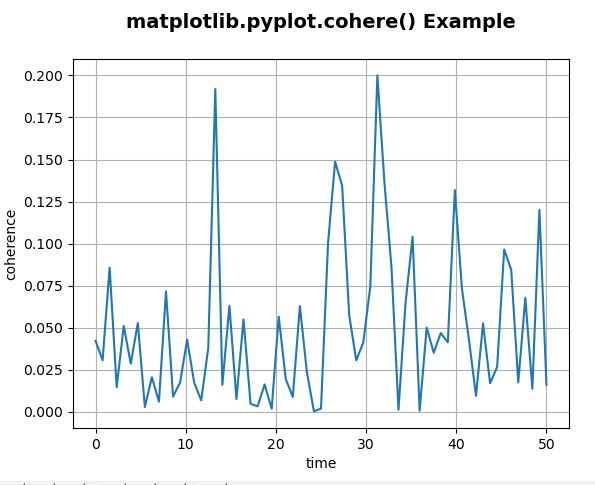Matplotlib是Python中的一个库,它是数字的-NumPy库的数学扩展。 Pyplot是Matplotlib模块的基于状态的接口,该模块提供了MATLAB-like接口。在Pyplot中可以使用各种图,例如线图,轮廓图,直方图,散点图,3D图等。
matplotlib.pyplot.cohere()函数:
matplotlib库的pyplot模块中的cohere()函数用于绘制x和y之间的相干性。相干性是归一化的交叉频谱密度。
用法: matplotlib.pyplot.cohere(x, y, NFFT=256, Fs=2, Fc=0, detrend=, window=, noverlap=0, pad_to=None, sides=’default’, scale_by_freq=None, *, data=None, **kwargs)
参数:此方法接受以下描述的参数:
- x, y:这些参数是数据序列。
- Fs:此参数是标量。默认值为2。
- window:此参数将数据段作为参数,并返回该段的窗口版本。其默认值为window_hanning()
- sides:此参数指定要返回频谱的哪一侧。它可以具有以下值:‘default’,‘onesided’和‘twosided’。
- pad_to:此参数包含填充数据段的整数值。
- Fc:此参数还包含一个整数值,用于抵消曲线图的x范围以反映频率范围。其默认值为0
- NFFT:此参数包含每个块中用于FFT的数据点数。
- detrend:此参数包含应用于fft-ing之前的每个段的函数,旨在删除均值或线性趋势{‘none’,‘mean’,‘linear’}。
- scale_by_freq:该参数允许对返回的频率值进行积分。
- noverlap:此参数是块之间的重叠点数。
- Fc:此参数是x的中心频率。
返回值:这将返回以下内容:
- Cxy:这将返回相干矢量。
- freqs:这将返回Cxy中元素的频率。
结果是(Cxy,freqs)
以下示例说明了matplotlib.axes中的matplotlib.pyplot.figure()函数:
范例1:
# Implementation of matplotlib function
import numpy as np
import matplotlib.pyplot as plt
dt = 0.01
t = np.arange(0, 30, dt)
nse1 = np.random.randn(len(t))
nse2 = np.random.randn(len(t))
s1 = 1.5 * np.sin(2 * np.pi * 10 * t) + nse1
s2 = np.cos(np.pi * t) + nse2
plt.cohere(s1, s2**2, 128, 1./dt)
plt.xlabel('time')
plt.ylabel('coherence')
plt.title('matplotlib.pyplot.cohere() Example\n',
fontsize = 14, fontweight ='bold')
plt.show()输出:

示例2:
# Implementation of matplotlib function
import numpy as np
import matplotlib.pyplot as plt
dt = 0.01
t = np.arange(0, 30, dt)
nse1 = np.random.randn(len(t))
nse2 = np.random.randn(len(t))
r = np.exp(-t / 0.05)
cnse1 = np.convolve(nse1, r, mode ='same')*dt
cnse2 = np.convolve(nse2, r, mode ='same')*dt
s1 = 1.5 * np.sin(2 * np.pi * 10 * t) + cnse1
s2 = np.cos(np.pi * t) + cnse2 + np.sin(2 * np.pi * 10 * t)
fig, [ax1, ax2] = plt.subplots(2, 1)
ax1.set_title('matplotlib.pyplot.cohere() Example\n',
fontsize = 14, fontweight ='bold')
ax1.plot(t, s1, t, s2)
ax1.set_xlim(0, 5)
ax1.set_xlabel('time')
ax1.set_ylabel('s1 and s2')
ax1.grid(True)
ax2.cohere(s1, s2, 256, 1./dt)
ax2.set_ylabel('coherence')
plt.show()输出:

相关用法
注:本文由纯净天空筛选整理自SHUBHAMSINGH10大神的英文原创作品 matplotlib.pyplot.cohere() in Python。非经特殊声明,原始代码版权归原作者所有,本译文未经允许或授权,请勿转载或复制。
